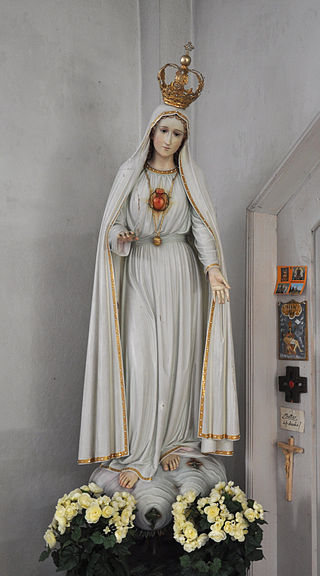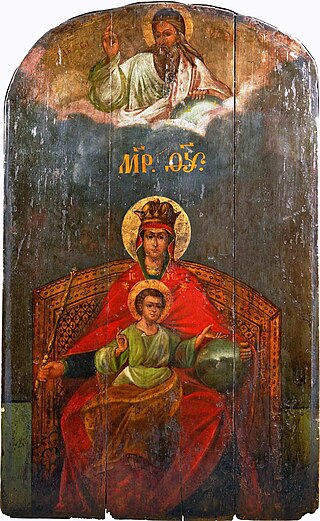
Blachernitissa, also called Theotokos of Blachernae or Our Lady of Blachernae, is a 7th-century encaustic icon representing the Most Holy Theotokos and Ever-Virgin Mary. It is also the name given to the Church built in honour of the Virgin Mary in the Blachernae section of Constantinople. The name Blachernae possibly derived from the name of a Vlach, who came to Constantinople from the lower Danube.

September 7 - Eastern Orthodox liturgical calendar - September 9

September 5 – Eastern Orthodox liturgical calendar – September 7

The consecration of Russia to the Immaculate Heart of Mary by a reigning pope was requested during a Marian apparition by Our Lady of Fátima on 13 July 1917, according to Lúcia dos Santos, one of the three visionaries who claimed to have seen the apparition. Sister Lucia said that at different times the Blessed Virgin Mary had given her a message of promise that the consecration of Russia to the Immaculate Heart of Mary would usher in a period of world peace.

Our Lady of Kazan, also called Mother of God of Kazan, is a holy icon of the highest stature within the Russian Orthodox Church, representing the Virgin Mary as the protector and patroness of the city of Kazan, and a palladium of all of Russia and Rus', known as the Holy Protectress of Russia. As is the case for any holy entity under a Patriarchate in communion within the greater Eastern Orthodox Church, it is venerated by all Orthodox faithful.

The Intercession of the Theotokos, or the Protection of Our Most Holy Lady Theotokos and Ever-Virgin Mary, is a Christian feast of the Mother of God celebrated in the Eastern Orthodox and Byzantine Catholic Churches on October 1 . The feast celebrates the protection afforded the faithful through the intercessions of the Theotokos.

The Kursk Root Icon of the Sign is an icon of Theotokos of the Sign, apparently painted in the thirteenth century and discovered in a forest near Kursk c. 1295.

March 2 - Eastern Orthodox liturgical calendar - March 4

The Feodorovskaya Icon of the Mother of God, also known as Our Lady of Saint Theodore and the Black Virgin Mary of Russia, is the patron icon of the Romanov family. It is one of the most venerated icons in the Upper Volga region. Her feast days are March 14 (27) and August 29.

The Theotokos of Bogolyubovo or Bogolubovo Icon is a Theotokos Agiosoritissa, a type of Marian icon, which is venerated and perceived as wonderworking by the Russian Orthodox Church. The icon was painted in 1157 at the request of Grand Prince Andrew Bogolubsky, in commemoration of an appearance to him by the Mother of God.
Marian feast days in the liturgical year are celebrated in honour of the Blessed Virgin Mary. The number of Marian feasts celebrated, their names can vary among Christian denominations.

The Mother of God of the Life-giving Spring or Life-giving Font is an epithet of the Holy Theotokos that originated with her revelation of a sacred spring in Valoukli, Constantinople, to a soldier named Leo Marcellus, who later became Byzantine Emperor Leo I (457-474). Leo built the historic Church of St. Mary of the Spring over this site, which witnessed numerous miraculous healings over the centuries, through her intercessions, becoming one of the most important pilgrimage sites in Greek Orthodoxy. Thus the term "Life-giving Font" became an epithet of the Holy Theotokos and she was represented as such in iconography.

The Cincture of the Theotokos is believed to be a relic of the Theotokos, now in the Vatopedi monastery on Mount Athos, which is venerated by the Holy Eastern Orthodox Church. The word "cincture" is sometimes also translated as "belt", "sash" or "girdle". It is the Orthodox equivalent of the Girdle of Thomas in the Western church, and the Syriac Holy Girdle. Its feast day is September 13.

The Theotokos of Tolga is a Russian Orthodox icon representing the Virgin Mary (Theotokos) with the infant Jesus Christ. The Theotokos of Tolga, named after the Tolga river in Yaroslavl, is known in three copies created between the end of the 13th and the beginning of the 14th century. They were drawn in Eleusa type. One of them, traditionally called a "Manifested" icon, was manifested to Prokhor, the Bishop of Rostov in 1314.

December 25 – Eastern Orthodox liturgical calendar – December 27

Our Lady Derzhavnaya is a Russian icon believed to date from the 18th century. According to Irina Yazykova, the Reigning Icon, "remains one of the most revered both inside Russia and in Russian emigre circles. Copies of the Reigning Icon of the Mother of God can now be found all over the world."

The Cathedral of the Nativity of the Theotokos is the main church of the city of Rostov-on-Don and the Orthodox Diocese of Rostov and Novocherkassk.

The Church of the Intercession of the Blessed Virgin Mary ― is a Russian Orthodox church in Kamensk-Shakhtinsky, Rostov Oblast, Russia. It belongs to Kamenskoe deanery of Shakhty and Millerovo Diocese of Moscow Patriarchate.

The Church of the Nativity of the Blessed Virgin Mary is a Russian Orthodox church in Konygin khutor, Ust-Donetsky District, Rostov Oblast, Russia. It was built in 1879 and belongs to Ust-Donetskoe deanery of Volgodonsk Diocese. It is also the oldest church in Ust-Donetsky District, which has been preserved to the present day.

The Cathedral of the Nativity of the Blessed Virgin Mary is the cathedral of the Diocese of Novosibirsk and All Siberia of the Russian Orthodox Old-Rite Church. It was built between 1990 and 1999. The cathedral is located in Zayeltsovsky District, Novosibirsk.















